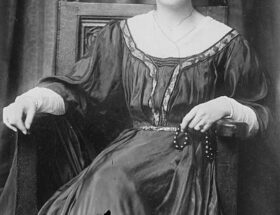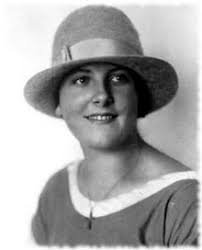
Early life
Sofiya “Sonya” Kalish was born in 1886 to a Jewish family in Tulchyn, Russian Empire (now Vinnytsia Oblast, Ukraine). She and her family arrived in Boston on September 26, 1887, under the surname Abuza as her father feared repercussions for having deserted from the Imperial Russian Army. The family lived in Boston’s North End for eight years and then settled in Hartford, Connecticut where they opened a restaurant.
At a young age, Sonya began singing at her parents’ restaurant for tips. Between taking orders and serving customers, she recalled that she “would stand up in the narrow space by the door and sing with all the drama I could put into it. At the end of the last chorus, between me and the onions, there wasn’t a dry eye in the place.”
In 1903, around the age of 17, Sonya eloped with Louis Tuck, a beer cart driver, from whom she later derived her professional surname. When she returned home, her parents arranged an Orthodox wedding for the couple.
In 1905, she gave birth to a son, Albert. However, shortly after her son’s birth, the couple separated and Sonya left the baby with her family and moved to New York City.
Career
After she left her husband, Willie Howard gave Sonya a letter of recommendation to Harold Von Tilzer, a composer and theatrical producer in New York. When it failed to bring her work, Sonya found jobs in cafés and beer gardens, singing for food and tips from the customers. She sent most of what she made back home to Connecticut to support her son and family.
In 1907, Sonya made her first theater appearance, singing at an amateur night in a vaudeville establishment. The producers thought that the crowd would tease her for being “so big and ugly.” Early in her career, she appeared in blackface as a minstrel singer, but she disliked this work and would sabotage the act by revealing that she was white at the end of the show.
She also began integrating “fat girl” humor, which became a common thread in her acts. Her songs included “I Don’t Want to Get Thin” and “Nobody Loves a Fat Girl, But Oh How a Fat Girl Can Love.”
In 1909, Sonya performed with the Ziegfeld Follies. Though she was a hit, the other female stars refused to share the spotlight with her and the company was forced to let her go. This caught the attention of William Morris, a theater owner and future founder of the William Morris Agency.
Two years later, Sonya released “Some of These Days” on Edison Records, written by Shelton Brooks. The title of the song was used as the title of Tucker’s 1945 biography.
In 1921, she hired pianist and songwriter Ted Shapiro as her accompanist and musical director, a position he would keep throughout her career. Besides writing a number of songs for her, Shapiro became part of her stage act, playing piano on stage while she sang, and exchanging banter and wisecracks with her in between numbers.
Sophie remained a popular singer through the 1920s and became friends with stars such as Mamie Smith and Ethel Waters, who introduced her to jazz. Sophie learned from these women and became one of the early performers to introduce jazz to white vaudeville audiences.
In 1925, Jack Yellen wrote “My Yiddishe Momme“, a song which became strongly identified with her and was performed in cities which had a significant Jewish audience. Sophie said “Even though I loved the song and it was a sensational hit every time I sang it, I was always careful to use it only when I knew the majority of the house would understand Yiddish. However, you didn’t have to be a Jew to be moved by ‘My Yiddishe Momme’.” The song was banned in Nazi Germany.
Sophie’s success had spread to Europe and she began a tour of England, performing for King George V and Queen Mary at the London Palladium in 1926. She re-released her hit song “Some of These Days”, backed by Ted Lewis and his band, which stayed at the number 1 position of the charts for five weeks beginning November 23, 1926 and sold over one million copies. It was also awarded a gold disc by the RIAA.
Sophie was strongly affected by the decline of vaudeville. Speaking about performing in the final show at E.F. Albee’s Palace in New York City, she remarked: “Everyone knew the theater was to be closed down, and a landmark in show business would be gone. That feeling got into the acts. The whole place, even the performers, stank of decay. I seemed to smell it. It challenged me. I was determined to give the audience the idea: Why brood over yesterday? We have tomorrow. As I sang, I could feel the atmosphere change. The gloom began to lift, the spirit which formerly filled the Palace and which made it famous among vaudeville houses the world over came back. That’s what an entertainer can do.”
In 1929, she made her first movie appearance in Honky Tonk. During the 1930s, Sophie brought elements of nostalgia for the early years of the 20th century into her show. She was billed as “The Last of the Red Hot Mamas” as her hearty sexual appetite was a frequent subject of her songs, unusual for female performers of the day after the decline of vaudeville.
In 1938, Sophie was elected president of the American Federation of Actors, an early actors’ trade union. Originally formed for vaudeville and circus performers, the union expanded to include nightclub performers and was chartered as a branch of the Associated Actors and Artistes.[18]
In 1939, the union was disbanded by the American Federation of Labor (AFL) for financial mismanagement. However, Sophie was not implicated in the proceedings. The AFL later issued a charter for the succeeding American Guild of Variety Artists, which remains active.
Marriages
Sophie was married three times. Her first marriage to Louis Tuck was oficially terminated in May 1913. Her son Albert was raised by his maternal aunt, Annie, with whom Sophie had a close relationship and kept in touch with weekly letters.
Her second marriage to Frank Westphal (1917–20), her accompanist and her third marriage to Al Lackey (1928–34), her manager, both ended in divorce and produced no children. She blamed the failure of her marriages on her being too adjusted to economic independence.
She said: “Once you start carrying your own suitcase, paying your own bills, running your own show, you’ve done something to yourself that makes you one of those women men like to call ‘a pal’ and ‘a good sport,’ the kind of woman they tell their troubles to. But you’ve cut yourself off from the orchids and the diamond bracelets except those you buy yourself.”
Later life & death
In 1938–1939, Sophie had her own radio show, The Roi Tan Program with Sophie Tucker, broadcast on CBS for 15 minutes on Monday, Wednesday and Friday. She made numerous guest appearances on such programs as The Andrews Sisters and The Radio Hall of Fame.
In the 1950s and early 1960s Sophie, “The First Lady of Show Business”, made frequent television appearances on many popular variety and talk shows of the day such as The Ed Sullivan Show and The Tonight Show. She remained popular abroad, performing for fanatical crowds in the music halls of London that were attended by King George V.
On April 13, 1963, a Broadway musical titled Sophie, based on her early life up until 1922, opened with Libi Staiger as the lead. It closed after eight performances.
Sophie continued to perform for the rest of her life. In 1962, she performed in the Royal Variety Performance, which was broadcast on the BBC. She appeared on the Ed Sullivan Show on October 3, 1965. For the color broadcast, her last television appearance, she performed “Give My Regards to Broadway“, “Louise“, and her signature song, “Some of These Days“.
Sophie died of lung cancer and kidney failure on February 9, 1966, aged 80, in her Park Avenue apartment. She continued working until her death, playing shows at the Latin Quarter just weeks before. She is buried in Emanuel Cemetery in Wethersfield, Connecticut.


